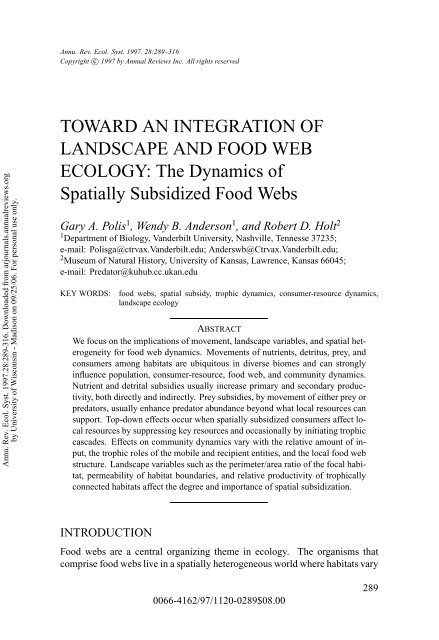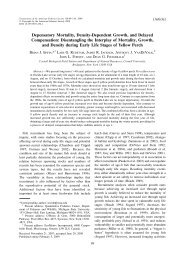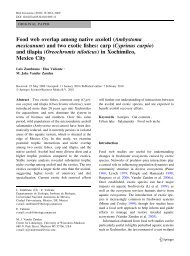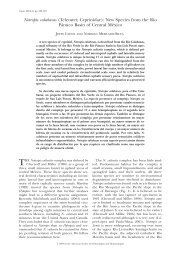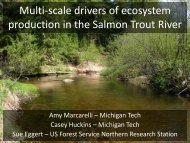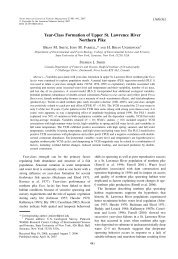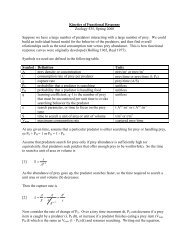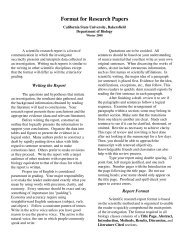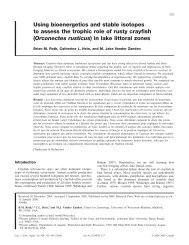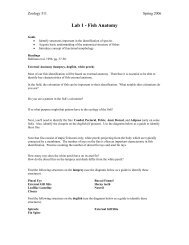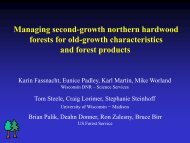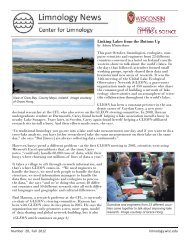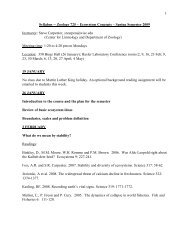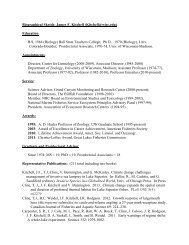TOWARD AN INTEGRATION OF LANDSCAPE AND FOOD WEB ...
TOWARD AN INTEGRATION OF LANDSCAPE AND FOOD WEB ...
TOWARD AN INTEGRATION OF LANDSCAPE AND FOOD WEB ...
Create successful ePaper yourself
Turn your PDF publications into a flip-book with our unique Google optimized e-Paper software.
290 POLIS, <strong>AN</strong>DERSON & HOLTAnnu. Rev. Ecol. Syst. 1997.28:289-316. Downloaded from arjournals.annualreviews.orgby University of Wisconsin - Madison on 09/25/06. For personal use only.greatly in productivity, resource abundance, and consumer behavior and demography.Even local communities that appear discrete are open and connected inmyriad ways to outside influences (75, 105, 135). The basic components offood webs—nutrients, detritus, and organisms—all cross spatial boundaries.Yet until recently, ecologists neglected to ask how spatial patterns and processesaffect web structure and dynamics (135). The core themes of landscapeecology—spatial variation in habitat quality, boundary and ecotonal effects,landscape connections, scaling, and spatial context (187–189)—carry significantimplications for food web ecology.We focus on spatial flows among habitats as a key force in local web dynamics.We first synthesize a large literature documenting the ubiquitous movementof material and organisms among habitats. We then show how spatial subsidiesinfluence consumer-resource and web dynamics, and we propose a preliminaryframework to integrate landscape and food web ecology. By spatial subsidy, wemean a donor-controlled resource (prey, detritus, nutrients) from one habitat to arecipient (plant or consumer) from a second habitat which increases populationproductivity of the recipient, potentially altering consumer-resource dynamicsin the recipient system.L<strong>AN</strong>DSCAPE CONSIDERATIONSConnectivity varies enormously among real systems, from near total isolationto strong mixing. Factors that influence exchange rate among spatial units are acentral focus of landscape ecology (50, 66, 170, 186). “Flow rate” depends ona suite of environmental and organismal attributes (e.g. habitat geometry andarea; similarity of, distance between, and relative productivity of interactinghabitats; boundary permeability; and organism mobility).The ratio of “edge” to “interior” (i.e. perimeter-to-area, P/A) is a majordeterminant of input to a habitat (137), e.g. watershed, riparian, and shorelineto and from streams and lakes (62, 132, 184, 185); the ocean to coastal areasand islands (137); and forest edge to interior (4, 6, 189). P/A is a functionof size (larger units have less edge per unit area), shape (e.g. compact vselongated), and fractal irregularity or folding of the edge (62, 137, 184). Suchedge effects are likely universal, governing input, productivity, and dynamicsamong juxtaposed habitats (135, 137).The “river continuum concept” (172) illustrates landscape influences onflow rates at several spatial scales. P/A declines from headwater streams tolarge rivers, with a corresponding decline in the relative importance of localallochthonous inputs compared to in situ productivity. Local production is reduceddownstream because of increased depth and turbidity, such that largerivers are net sinks for energy and material derived from smaller order streams;upstream subsidies drive downriver dynamics. Finally, the contribution of
SPATIAL SUBSIDIES IN <strong>FOOD</strong> <strong>WEB</strong>S 291allochthonous stream material to lakes or oceans is governed by landscape factors(e.g. small source streams or short rivers should contribute relatively morethan longer or larger rivers).Annu. Rev. Ecol. Syst. 1997.28:289-316. Downloaded from arjournals.annualreviews.orgby University of Wisconsin - Madison on 09/25/06. For personal use only.FLOW <strong>AN</strong>D SPATIAL SUBSIDIES: DIRECT EFFECTSAllochthonous input can influence greatly the energy, carbon (C), and nutrientbudget of many habitats. In general, nutrient inputs (nitrogen [N], phosphorus[P], trace elements) increase primary productivity; detrital and prey inputsproduce numerical responses in their consumers. Transport across boundariesoccurs via either physical or biotic vectors. Wind and water are the primaryphysical vectors; they transport subsidies either by advection or diffusion (44).Mobile consumers transport nutrients and detritus when they forage in one habitatand defecate in another. We organize trophic flows by origin and destinationusing two comprehensive categories, water and land.Movement of Nutrients and DetritusWATER TO WATER Water masses often differ substantially in productivity andorganic biomass. Transport, both vertical (upwelling, pelagic detrital fallout tobenthos) and horizontal (currents, tidal movement, eddy-diffusion), is generallya key determinant of local marine productivity and consequent food webs.In particular, pelagic-benthic coupling is a major route for energy and nutrientflow (7, 13, 14, 16, 90, 98, 140). Much shallow water benthos consistsof sessile particle or detritus feeders that rely on settlement of food from thecoastal fringe and production from overlying waters. In situ benthic productivityis relatively unimportant (most areas) or totally absent (aphotic zones).Worldwide, the biomass of benthic fauna reflects the productivity of overlyingwaters (13, 98, 140). Conversely, infusion of nutrients from bottom via bothmixing and upwelling controls primary productivity of surface waters (13, 14,98).Benthic and pelagic lake habitats are connected via turnover, a process similarto upwelling whereby bottom nutrients, reinfused into photic waters, stimulateproductivity. Lakes also receive many nutrients from streams, springs, precipitation,watershed soil and fertilizer runoff, shore vegetation, and litter fall (132,see below). In beaver ponds, biomass input from streams is three times greaterthan local production (116). One implication of the river continuum conceptis that downstream communities are subsidized by upstream “inefficiencies” inC retention and processing (117, 179). In some systems, such input is quiteimportant, e.g. in a Washington esturary, rivers contributed four to eight timesmore organic material than all local producers combined (165).Plant detritus produced in one habitat and transported to a second can subsidizedetritivores. Productive kelp and seagrass beds fuel dense detritivore
292 POLIS, <strong>AN</strong>DERSON & HOLTAnnu. Rev. Ecol. Syst. 1997.28:289-316. Downloaded from arjournals.annualreviews.orgby University of Wisconsin - Madison on 09/25/06. For personal use only.populations in the supralittoral (137), littoral (49), intertidal (32), and deepbenthic zones (174).Large consumers transport material among aquatic habitats. Seasonally anddaily migrating fish are particularly important conduits. Anadromous fish (e.g.salmon) deposit great amounts of energy and nutrients of marine origin to lakesand nutrient-deficient headwater streams via reproductive products, excretion,and death (51). For example, dead salmon contribute 20–40% of total lakeP (51); abundant (9 × 10 8 to 4.4 × 10 10 /year) marine alewives leave up to146 g/m 2 in freshwater when they die. Nutrients from dead anadromous fishappear critical to sustain productivity of many freshwater and riparian ecosystems(15a, 51, 192).Daily movement by fish and zooplankton facilitates rapid nutrient translocationacross boundaries in freshwater (35, 89, 152, 171) and marine systems(7, 108, 124, 145). Such movement transports great quantities of fecal matterrich in fertilizing nutrients within the water column (the “diel ladder”; 89), betweenbenthic and pelagic waters (“nutrient pump mechanism”; 171), betweenonshore and offshore waters (22), and to refuge areas (108, 124). In lakes, Pinput via fish excretion can exceed all other inputs, greatly increasing primaryproductivity, altering the outcome of phytoplankton competition, and stimulatingtrophic cascades (34, 171). Detritivorous benthic fish facilitate energy flowthrough lake webs by infusing DOM and P into the water in forms useful tophytoplankton (171). Marine fish transport nutrients and energy from feedingto resting areas, e.g. N and P from seagrass beds into nutrient-poor waters overcorals, which thus increases coral growth rates. These effects are likely generalin many marine habitats (26, 109).Seabirds feeding on fish and invertebrates concentrate and transport greatquantities of nutrients in their guano. Guano, a powerful fertilizer, enhancesnutrient status and primary production in the intertidal and nearshore marineand estuarine waters (19, 82, 195).L<strong>AN</strong>D TO WATER Aquatic and terrestrial systems are often linked functionallyby flows of nutrients and organic matter via wind or water moving in the hydrologiccycle (67). In general, food webs in rivers, lakes, and estuaries are fueledby both local primary productivity and allochthonous detritus. Terriginousinput is a major factor (along with upwelling and an enhanced light regime)that promotes high primary and secondary productivity in coastal waters, bothmarine (13, 98) and freshwater (171, 185). Three major conduits shunt materialfrom land to freshwater (67, 179, 185): detritus from leaf and litter fall;dissolved and particulate organic matter (DOM, POM) from soil runoff (107,110, 113, 117, 170); and detritus, POM, and DOM from floods (64, 114, 178,179).
SPATIAL SUBSIDIES IN <strong>FOOD</strong> <strong>WEB</strong>S 293Annu. Rev. Ecol. Syst. 1997.28:289-316. Downloaded from arjournals.annualreviews.orgby University of Wisconsin - Madison on 09/25/06. For personal use only.The impact of such input on energy budgets and community structure dependson many landscape variables: location in a drainage, nature of the terrestrialsurroundings, watershed size, amount of terrestrial runoff, and shoreline towater P/A ratio (40, 93, 109, 132, 152, 165, 172, 185). Often, input greatlyexceeds in situ productivity (18, 58, 165). For example, primary productionin ponds (2.4% of C budget), stream riffles (10%), and streams (4.2%, 16%)is substantially less than allochthonous input (respectively, 80%, 76%, 91%,74%; 116, 117). Plants usually benefit greatly from nutrient and DOM input(58, 109, 113).In floodplain ecosystems, great amounts of detritus, nutrients, and sedimentsrich in organics are exchanged reciprocally between the river channel and theriparian land via flooding (178, 179, 182). Materials produced on land duringdry phases increase productivity of aquatic plants and are a rich food supply fordetritivores that move onto the floodplain from the channel during floods (193).Annual floodplain input of total C to a river channel in Georgia was seventimes greater than in situ production (55). Blackwater river productivity ispowered by inputs from terrestrial systems (15, 64, 106). In Amazonian rivers,“...primary productivity is so low that a food chain could not be built up fromendogenous sources alone to support a large biomass of animals” (63: p. 252).The web is based strongly on allochthonous input of organisms and detritus.“The rainforest, in its floodplain manifestation, has come to the trophic rescueof these aquatic ecosystems” (63, p. 252). An estimated 75% of market fishreceive substantial input (50–90% of diet) from terrestrial origin (fruit, seeds,insects, small vertebrates).Birds and mammals foraging on land can transport great quantities of detritusand nutrients to water, e.g. geese, gulls, and hippopotamuses defecate rich fecesinto water. Well-studied birds bring terrestrial nutrients to lakes via guano (27,82); e.g. birds bring 36% of the annual P input into some ponds, increasingplant abundance (102). Beaver-transported trees add nutrients and much organicmatter (1 ton/beaver/year) to ponds (85), establishing an entire food chain basedon wood decomposition (111, 115, 116). In the Amazon Basin, many fishimport great amounts of energy and nutrients from terrestrial habitats (riparian,flood forest, and floodplains) to rivers (63, 64).WATER TO L<strong>AN</strong>D Conversely, terrestrial organisms benefit from periodic nutrientenhancement from aquatic habitats. This water-land linkage is well knownto humans and is exemplified by the agriculturally based cultures along thefertile bottom lands of major rivers (e.g. Nile, Mississippi). The area affectedcan be great: the Amazon floods 2% (70,000 km 2 ) of its adjacent forest annually(63). Lake material is an important source of organic matter in borderingland habitats (132). Flooding and winds transport lake plants in quantities
294 POLIS, <strong>AN</strong>DERSON & HOLTAnnu. Rev. Ecol. Syst. 1997.28:289-316. Downloaded from arjournals.annualreviews.orgby University of Wisconsin - Madison on 09/25/06. For personal use only.(7.4 kg/m 2 /year of shoreline) 4.5 times greater than in situ terrestrial productivity.Such input produces an “edge effect,” with greater diversity and densitiesin the riparian than surrounding habitats (36, 83, 132).Coastal areas fringing oceans worldwide receive great amounts (10 −→ 2000kg/m shoreline/year) of organic matter from the sea via shore wrack (algae andcarrion) (32, 68, 69, 96, 137) and possibly from N-rich seafoam (78, 162).Seabirds transport substantial nutrients and organic material to land via guano,food scraps, eggs, feathers, and bodies of dead chicks and adults (82, 114,137). Birds that feed on massive schools of Peruvian anchovetta deposit guanoto mean depths of 5.4–28.5 m, with three offshore islands each containing 2.3–5.2 × 10 6 metric tons (76). Worldwide, seabirds annually transfer 10 4 –10 5 tonsof P to land (114).L<strong>AN</strong>D TO L<strong>AN</strong>D Surprisingly great amounts and variety of windborne detritusand nutrients arrive from near and far and may totally sustain or partiallysubsidize local webs (10, 53, 78, 97, 154, 162, 164). “Aeolian ecosystems”(162) fueled by windborne input (53, 78) include caves, mountaintops, snowfields,polar regions, new volcanic areas, phytotelmata, and barren deserts andislands. In these systems, local plant productivity is low or absent; yet diverse,detrital-based webs exist with abundant consumers at several trophic positions.Such webs characterize high-altitude and snow-covered habitats worldwide(10, 53, 97). “Truly immense quantities of pollen grains of many differentplants, spores of fungi and of Protozoa, seeds of a great variety of plants, ...and nearly every conceivable group of winged and apterous insects, spiders,etc brought by the upper air currents, are frozen and entombed in the snow andglacier ice” (97, p. 70). Melted water carries detritus and carcasses to streamsto provide a rich food for insects.Worldwide, nutrient budgets of many terrestrial ecosystems depend on nutrientstransported aerially (94). Such subsidies may compensate for low-nutrientsoils in temperate forest communities (9). In much of the Amazon Basin, wheresoils are nutrient poor due to limited river deposition, airborne soils apparentlyare needed to achieve a nutrient balance (86, 176). Most P, a critical elementthat limits net primary production, is intercontinental: 13 million tons (13–190kg/ha/year) is carried by dust blown from the African deserts 5000 km away(163)! Such input doubles the standing stock of P over 4.7–22 ky. Thus, the productivityof Amazon rainforests depends critically upon fertilization from anotherlarge ecosystem, separated by an ocean yet atmospherically coupled (163).Consumers that redistribute large quantities of biomass include mammalianherbivores (e.g. grazers in the Serengeti; 103) and roosting or nesting birds(181). Bats, rats, birds, and crickets are major conduits of energy via guanointo caves (42, 79, 82). Great quantities of fecal fruit and seeds from Peruvian
SPATIAL SUBSIDIES IN <strong>FOOD</strong> <strong>WEB</strong>S 295Annu. Rev. Ecol. Syst. 1997.28:289-316. Downloaded from arjournals.annualreviews.orgby University of Wisconsin - Madison on 09/25/06. For personal use only.oil birds form the base of a diverse cave food web: bacteria, fungus, and >50species of arthropods (47). Caves worldwide are similar; they receive all energyallochthonously via animals, root exudates, and water flow that deposits surfacedetritus; such input supports many detritivores, scavengers, fungivores, and arich predator guild (42, 79, 99).Movement of PreySpecies produced in one habitat frequently end up as food elsewhere. Movementmay be accidental (e.g. by winds), or a product of life history (e.g. migration,ontogenetic habitat switches) or interactions (e.g. interference).WATER TO WATER The ubiquitous horizontal and vertical movement of watertransports nutrients (see above) and prey. The prey of filter feeders may beproduced locally, in adjacent habitats, or far away. Downstream movementof prey characterizes streams and rivers; generally, most productivity is fixedin riffles, yet most consumption occurs in ponds, often subsidizing residentpredators (39, 116, 117).Members of the “deep scattering layer” move 300–1500 m to feed at nightin the photic zone and return to deeper waters during the day. These dielmigrants carry much primary productivity to depths where they form the preyof large populations of fish and invertebrate predators (7). On deep seamountsin areas of very low in situ productivity, many fish species eat great amountsof prey carried to them by currents and vertical migrations; the populationbiomass of these fish is an order of magnitude higher than populations that donot receive allochthonous prey (90). Life history migrations of species at alltrophic positions at several temporal scales connect food webs of marine pelagicand benthic habitats (the “jellyfish paradigm”; 16; but see 61). Diadromousmigration of fish transport large numbers of potential prey between marine andfreshwater habitats.L<strong>AN</strong>D TO WATER Some aquatic consumers eat terrestrial prey. Fish and aquaticinsects eat insects and spiders that drop to streams (63, 193), often in great numbers(100). These amounts may surpass production of in situ aquatic insects.Many salmonids eat “an astonishing diversity” of terrestrial prey (80), at leastseasonally; such prey can form >50% of annual energy uptake (80, 100). Landinsects from 70 families provide ≈10% of fish diet in a Swedish lake (121).An abundance of insects blow onto the ocean, both near and far from shore(21, 37, 38). On a typical summer day, an estimated 4.5 billion insects driftover the North Sea from a 30-km coastal strip (38). Greater numbers can occur.Off Nova Scotia, an estimated 800 billion budworm moths formed a floatingslick 100 × 66 km (21). An estimated mean of 2–17 million insects annuallydrop onto each km 2 of ocean surface worldwide; this equals 2–17 kg/m 2 /year,
296 POLIS, <strong>AN</strong>DERSON & HOLTor 0.01% of phytoplankton productivity (38). Although insects contribute littleto the energetics of ocean ecosystems, they form 27%–60% of the prey volumeof some fish and may have large impacts in low-productivity regions.Annu. Rev. Ecol. Syst. 1997.28:289-316. Downloaded from arjournals.annualreviews.orgby University of Wisconsin - Madison on 09/25/06. For personal use only.WATER TO L<strong>AN</strong>D Many land consumers eat prey of aquatic origin. Emergingaquatic insects are eaten by terrestrial insects, arachnids, amphibians, reptiles,and birds; such consumers often occur in large populations at the marginsof water (36, 70, 83, 118, 136, 137, 138, 146). Only ≈3% of emerging insectbiomass remained in a desert stream, with 23 g/m 2 /year (400–155,000individuals/m 2 /year) exported to the adjacent riparian zone (83). Such greatexport can be crucial to terrestrial predators, affecting abundance, territoriality,feeding behavior, and reproductive success (83). Seabirds and their associatedectoparasites are a major food of many consumers (48, 137).Anadromous fish are important prey of diverse consumers in many terrestrialhabitats, e.g. ≈50 species of birds and mammals eat salmon in Alaska (192).These fish “appear to be a keystone food resource for vertebrate predatorsand scavengers, forging an ecologically significant link between aquatic andterrestrial ecosystems” (192, p. 489) and appear critical to the success of manyconsumers. This interaction carries important conservation implications; theloss of such fish could exert major effects on these species and their community.L<strong>AN</strong>D TO L<strong>AN</strong>D Winds frequently transport prey great distances. Windbornearthropods allow stable populations of predators to persist on barren volcanicfields and new volcanic islands (52, 54, 78, 166, 168). Insects also waft tomountain tops and snowfields (52, 53, 97, 162) where they are eaten by diverseand abundant predators. Over 130 species of arthropods, most from lowlandhabitats, can occur on barren snowfields (10). “Surprisingly large numbers” ofdiverse consumers in every trophic category “gorge” with foods “refrigeratedin the snows” (97, p. 70). Webs with “every class of feeder” are driven byallochthonous foods (97). In these examples, airborne prey sustained predators(e.g. spiders, insects, lizards, birds, and small mammals) in a system lackinglocal primary productivity.Prey movement among habitats often characterizes insect life cycles. Brown& Gange (28) give many examples of the generalized life-cycle of such insects:Females deposit eggs into the soil; larvae, which feed underground on rootsor detritus, pupate there; and adults emerge to mate aboveground. Such a lifecycle characterizes some of the most successful insects: Almost all termites,ants, cicadas, and many beetles, moths, and flies transport belowground organicmaterial to aboveground consumers (112, 161). In the case of periodic cicadas(the land animal with the greatest biomass/area), predators feed to satiation onemergent adults (28).
SPATIAL SUBSIDIES IN <strong>FOOD</strong> <strong>WEB</strong>S 297Life-history migrations transport prey great distances. For example, monarchbutterflies eat temperate milkweed but overwinter in Mexico where they areeaten by tropical birds (33). Similar transport occurs via other migratory animals,e.g. songbirds (92), mammalian grazers (150), and locusts.Annu. Rev. Ecol. Syst. 1997.28:289-316. Downloaded from arjournals.annualreviews.orgby University of Wisconsin - Madison on 09/25/06. For personal use only.Movement of ConsumersConsumers’ movement ranges from fine (e.g. local foraging paths) to broadscales (e.g. long-distance migration). Many mobile consumers, migrants, andage classes choose habitats based on relative profitability of forage intake (36,155, 183). However, some consumers move into habitats with relatively lowproductivity to avoid interference or predation (73, 127). A vast number ofspecies change feeding habitats during their lifetime (see 135 for examples andfood web implications of ontogenetic habitat shifts by consumers).WATER TO WATER Aquatic species exhibit a continuum of horizontal and vertical,short and long migrations. The “food availability hypothesis” for theevolution of diadromy in 128 species of fish (65) posits that relative productivityof marine and riverine environments at a given latitude determines if fishfeed and grow in the ocean and move to freshwater to reproduce (anadromy)or vice versa (catadromy). Anadromy is more frequent when ocean productivityexceeds neighboring freshwater productivity (temperate, arctic). Manydiadromous fish also feed in the less productive habitats and can exert greateffects on prey in these places, e.g. anadromous steelhead in California rivers(141). Stable isotope analyses show the relative importance of coupled habitatson anadromous and estuarine fish (15a, 60).Shorter migrations occur. Krill move annually from the Antarctic ice shelf,where they graze on algae, to pelagic zones, where they eat phytoplankton (157).This cycle may be central to southern oceans ecosystem dynamics. Feeding onice algae (along with fat storage and cannibalism) allows krill to overwinter andbe present in great numbers in the spring. Such seasonal and regional switchesof food resources hypothetically explain two mysteries: the maintenance ofvery large populations and biomass of krill in this oligotrophic community, andthe rapid suppression of phytoplankton during their exponential growth phasein spring.In general, marine zooplankton, fish, birds, and mammals aggregate nearregions of high productivity and food density (e.g. upwelling, frontal regions)(3, 14, 173). Crustacean densities inside frontal regions are 74.5 times greaterthan outside (14). Large populations of consumers migrate from deep waterto feed on near-surface resources (7). Both marine and freshwater fish forageacross habitats that vary in prey availability, e.g. pelagic and littoral zones (95,111, 130), coral reef and sand flats (142), river and floodplain (63, 182).
298 POLIS, <strong>AN</strong>DERSON & HOLTAnnu. Rev. Ecol. Syst. 1997.28:289-316. Downloaded from arjournals.annualreviews.orgby University of Wisconsin - Madison on 09/25/06. For personal use only.BETWEEN WATER <strong>AN</strong>D L<strong>AN</strong>D Many species of land and seabirds eat both aquaticand land prey (29, 30, 156, 159). Sixteen Crozet Island species forage in theocean, in freshwater, and on land (81). Predation by coastal seabirds significantlyinfluences land invertebrates by consuming 24 tons/100 km 2 /year; landprey form 12%–25% of their total annual energy intake (156). Many landpredators forage along shores (137, 146, 192). Along coasts worldwide, mammalsand land birds eat living marine species and carrion (30, 126, 146). Suchsubsidies allow these species to maintain relatively large coastal populationsthat also forage on “typical” terrestrial prey (146).L<strong>AN</strong>D TO L<strong>AN</strong>D Many taxa move at varying temporal and spatial scales (patchesto continents) to use distinct habitats. The dependency on spatially andtemporally variable resources (fruit, nectar, insects) necessitates that birds behighly mobile to track changes in resource abundance across geographic scalesranging from within trees to between altitudinal zones, and from intrahabitatshifts to intercontinental migrations (92). Many consumers move 200–500 mfrom the edge of adjacent fields to exploit forest birds (4, 6, 143, 189). Landscapeconsiderations are important: Nest predation is greater in areas closerto the edge (6, 189) and is a function of P/A ratio of the forest (greaternest predation in smaller fragments; 4, 143). Predators entering habitat islandssignificantly affect the composition, abundance, and dynamics of aviancommunities.Movement by parasitic and pathogenic consumers among “habitats” (hosts)is a key to parasite-host (17) and pathogen-resource dynamics (144, 177). Alternativehosts frequently support parasites (e.g. of humans; 17) or pathogens;infection occurs via movement of either the alternative host or infective stages ofpathogens. A typical control measure is to eliminate “reservoir” species of alternativehosts. However, such measures are often only partially successful—e.g.local infection rates are influenced by spores from distant outbreaks (144, 177).Further, most parasites with complex life histories and many plant pathogensrequire “landscape complementation” (50) of resources. For example, somerust fungi must move among alternative hosts to develop, e.g. cedar-apple rustalternates between apples and eastern red cedar (144).FLOW <strong>AN</strong>D SPATIAL SUBSIDIES: INDIRECTEFFECTS ON TROPHIC DYNAMICS“Tropho-spatial” linkage is often a key factor in local dynamics. Recipientspecies almost always benefit from inputs. Food web effects depend on webconfiguration and the trophic roles of the mobile entity (e.g. nutrients, basalspecies, predators) and recipient (basal, intermediate, or top species) (1, 139).
SPATIAL SUBSIDIES IN <strong>FOOD</strong> <strong>WEB</strong>S 299Annu. Rev. Ecol. Syst. 1997.28:289-316. Downloaded from arjournals.annualreviews.orgby University of Wisconsin - Madison on 09/25/06. For personal use only.Donor ControlInteractions between consumers and allochthonous resources are typically donorcontrolled, i.e. consumers benefit from but do not affect resource renewal rate(i.e. no recipient control; 131, 135, 139). Donor control occurs whenever aresource population is spatially partitioned into subpopulations that occupydifferent compartments, only one of which is accessible to consumers (36,139). For mobile consumers, some feedback is likely, i.e. recipient control ofresources by consumers may occur in either habitat.Movement of NutrientsWe suggest that nutrient input is a major factor in open systems (and we arguethat most systems are open); by contrast in closed systems, in situ herbivores anddecomposers regulate nutrient recycling rates and availability to plants (171). Ifallochthonous nutrients enrich plants, primary productivity will increase, oftendramatically (see earlier). Nutrient enrichment also increases plant quality. Herbivoresurvival and reproduction often depends more on host N concentrationthan on C availability (101, 139). Consequently, nutrient-subsidized systemsoften exhibit elevated densities of herbivores and higher-level consumers.Mixing and upwelling of nutrients in the ocean stimulate phytoplanktonblooms, followed by numerical responses through the web: Zooplankton increase,and nekton and vertebrates move to plankton concentrations (13, 14,98). Upwelling drives oceanic production: Upwelling ecosystems account forjust 0.1% of the ocean’s surface, but 50% of the world’s fish catch (13, 14).Cessation of upwelling sharply depresses pelagic productivity at all levels; e.g.El Niño events produce population collapses of seabirds, mammals, marineiguanas, and invertebrates off the Americas (14).Exchange of nutrients between pelagic/littoral zones and intertidal zones canbe quite important. Nutrient enhancement from coastal upwelling allows intertidalalgae and higher-level consumers to increase productivity and standingstock (19). Nutrient input from oceanic waters may be a key “bottom up” factorin intertidal community structure (104). Fertilization effects of seabird guanoon intertidal algae also can propagate up the web (25, 194): Invertebrate consumersgrow faster and larger, reproduce more, and increase in density. Thedensity of birds eating these invertebrates is 2–3.8 times greater than in unaffectedareas (194). Conversely, nearshore productivity can increase secondaryproductivity of adjacent marine waters (98, 119).In freshwater systems, large populations of herbivores/detritivores are fueledby detrital input from land and by aquatic plants using nutrients ultimately derivedfrom terrestrial systems (40, 57, 147). Areas receiving P and N in runoffdevelop productive, “nutrient subsidized” phytobenthic assemblages that thensupport a rich zoobenthic community (179). Anthropogenic nutrients (e.g. from
300 POLIS, <strong>AN</strong>DERSON & HOLTAnnu. Rev. Ecol. Syst. 1997.28:289-316. Downloaded from arjournals.annualreviews.orgby University of Wisconsin - Madison on 09/25/06. For personal use only.sewage, fertilizer, phosphate detergents) increase productivity, cause eutrophication,and significantly alter lake and estuarine communities (34, 44). Astriking “dead zone” in the Gulf of Mexico is linked to fertilizer input fromNorth America’s agricultural regions (87).Nutrient subsidies likewise affect terrestrial systems. Fixed N from atmosphericpollution arrives in sufficiently large quantity via rain to change plantspecies composition and productivity, alter the outcome of plant competition,and disrupt entire communities worldwide (56, 84, 175). Guano, rich in Nand P, enhances the quality and quantity of land plants and underlies entirefood webs in coastal and insular ecosystems worldwide (19, 31, 82, 91, 102,137; WA Anderson, GA Polis, unpublished data). In inland Antarctica, allochthonousguano provides the only nutrients to sustain lichens, which thensupport microorganisms and arthropods (149). These communities occur onlyaround bird colonies.Nutrient enrichment subsidizes plants and also indirectly influences herbivoresand predators (34, 35, 139, 171). Thus, although nutrient input increasesproductivity, effects on system stability are unclear (44, 45, 160). The “paradoxof enrichment” (148) suggests that reducing nutrient limitation can destabilizeplant-herbivore interactions—plant populations become susceptible to overgrazingby indirectly subsidized herbivores (44, 148). For example, bird guanoincreases N concentration and growth rates of mangroves; fertilized plants losefour times more tissue to abundant herbivorous insects than do unfertilizedplants (129).Movement of DetritusCross-habitat flows of detrital subsidies (122, 164) often produce bottom-upeffects in marine, freshwater, and terrestrial systems: Detritivores and theirconsumers increase throughout the web (see earlier). Diverse webs form evenwhere local productivity is largely (or totally) absent: caves (42, 47, 79, 99),barren oceanic islands (74, 137, 138, 166, 167, 168) and deserts (154), lightlimitedzones of oceans and lakes (13, 174), blackwater rivers (15, 63, 64),and aeolian environments (162) such as lava flows (78, 168), mountaintops(53, 97), and polar areas (149, 164). The most biomass-rich community onearth is supported 100% by allochthonous detritus: 15–300 m mats of detritalsurfgrass and kelp are converted into >1 kg/m 3 of benthic crustaceans (up to3 × 10 6 individuals/m 3 ); large numbers of trophically distinct fish feed in these“hotspots” (174).In other marine systems, detrital input allows species throughout the web toincrease productivity and standing stock (20, 23, 32, 49, 104). Faunal biomasson beaches receiving various energy subsidies, from either upwelling or planktonblooms, is one to three orders of magnitude greater than on beaches without
SPATIAL SUBSIDIES IN <strong>FOOD</strong> <strong>WEB</strong>S 301Annu. Rev. Ecol. Syst. 1997.28:289-316. Downloaded from arjournals.annualreviews.orgby University of Wisconsin - Madison on 09/25/06. For personal use only.subsidies (12). Islands receiving detrital shore wrack often support diverse andabundant consumers (68, 137, 138). Abundant beach detritus from a successfulkelp restoration project allowed several seabird species that eat kelp detritivoresto recover (23). Inputs from extremely productive marshes, estuaries, and seagrassand mangrove areas contribute substantially to secondary productivity inadjacent coastal waters; e.g. an estimated 3.5–8 metric tons/ha of mangrovedetritus is exported offshore annually (123). Many stream consumers directlyand indirectly rely heavily on terrestrially produced detritus as a major energysource (40, 41, 184, 185)Numerical responses of subsidized detritivores can depress in situ resources.Intertidal grazers can occur at very high densities if they receive kelp detritusthat originates sublittorally (32, 49, 105). These dense intertidal herbivoresthen graze noncoralline algae to low cover. Leaffall is the major energy sourceproducing great numbers of herbivorous stream snails; snails, so subsidized,depress in situ algae (147).Movement of PreyPrey input allows predators to increase locally, as observed for diverse consumersin many habitats (see earlier). Top down effects occur when subsidizedconsumers increase densities and depress local resources. The dynamics ofsuch donor-controlled interactions exhibit several features. First, because subsidizedconsumers cannot depress the renewal rate of imported prey, they areassured of a food supply that they cannot overexploit. Second, consumer successis decoupled at least partially from the constraints of local productivity andprey dynamics. Third, subsidized consumers can depress local resources belowlevels possible from isolated in situ consumer-resource dynamics in an interactionparallel to apparent competition (72, 77); however, instead of an alternativeprey, an alternative habitat furnishes resources to consumers (or provides foodfor mobile consumers; see below). Thus, imported foods permit consumers tooverexploit resident prey, even to extinction, without endangering the predatoritself. Note that donor-controlled input decouples resource suppression from insitu productivity (73, 126, 127, 138, 139). Consequently, spatial subsidies canlead to dynamics and abundance patterns inconsistent with consumer-resourcemodels (e.g. 8, 125) based solely on in situ productivity (135, 139). Fourth,effects are generally asymmetric: Prey in less productive habitats are affectedmore adversely than are those in more productive habitats.We illustrate these dynamics. In a California vinyard, two-spotted mites movefrom grass to less productive grapevines. This prey input allows populationsof predaceous mites on the vines to increase and suppress populations of an insitu pest, the Willamette mite, to lower densities than without spatial subsidy(59). In the Serengeti, nomadic herds track rainfall to forage in relatively
302 POLIS, <strong>AN</strong>DERSON & HOLTAnnu. Rev. Ecol. Syst. 1997.28:289-316. Downloaded from arjournals.annualreviews.orgby University of Wisconsin - Madison on 09/25/06. For personal use only.productive habitats (155). Migratory prey (e.g. wildebeest) are thought to allowresident lions to increase to the point that they depress resident species (e.g.warthogs, impala; 150). Heavy poaching of mobile Cape buffalo outside theSerengeti lowered their numbers in the game park, causing lions to decreasesubstantially, with increases in several alternative prey species (AR Sinclair,personal communication).Subsidized consumers can influence entire communities if they suppresskey species. Communities should be more stable if subsidies allow consumersto suppress species capable of explosive reproduction (e.g. sea otter examplebelow). Subsidized predators can increase so much that they depress herbivores,thus allowing plants to be more successful—an “apparent trophic cascade”—apparent because energy sustaining high consumer densities is not from in situproductivity (as usually modeled) but arises outside the focal habitat (138).We cite four examples of trophic cascades subsidized by allochthonous prey.Large numbers of lumpsucker fish that migrate periodically from deeper watersare eaten by sea otters; such prey help maintain equilibrium densitiesof otters and allow control of sea urchins, thus releasing kelp from intenseherbivory (180). Abundant coastal spiders eat many marine Diptera and suppressinsect herbivores; plant damage is significantly less than on plants unprotectedby subsidized spiders (136). Spiders along German rivers, subsidizedby abundant aquatic insect prey, suppress herbivores, thus lessening damage toplants (J Henschel, personal communication). Detritivorous soil insects fromgaps (herb/grass layer) in tropical forests are the major food of canopy anoles(46). Landscape considerations are important: Canopies immediately downwindfrom a gap support twice the flying insects and lizards as do closedcanopies or those adjacent to, but upwind of, a gap. In subsidized areas, anolesdepress resident herbivores, and plants show significantly less damage. Subsidizedanoles also depress arboreal spiders, thus indirectly allowing smallinsects to increase. In each example above, prey import is donor controlled,spatially subsidized consumers exert recipient control on local prey, and suchprey depression indirectly makes resources of these prey more successful.Finally, prey movement can homogenize patches of differing productivityby linking predators with prey produced elsewhere. Prey flow from riffles topools can be great: Drifting insects (50–1300/100 m 3 ) subsidize resident poolpredators and overwhelm predator effects on local prey populations (39). Thisprocess is a function of the number of prey moving, habitat isolation, and ratesof immigration versus local depletion (41, 72). Thus, although predators mayremove many prey individuals, prey input may make mask predator effects (39).Movement of ConsumersConsumer movement produces effects generally similar to those of prey movement(but see below): Consumers usually persist at densities higher than
SPATIAL SUBSIDIES IN <strong>FOOD</strong> <strong>WEB</strong>S 303Annu. Rev. Ecol. Syst. 1997.28:289-316. Downloaded from arjournals.annualreviews.orgby University of Wisconsin - Madison on 09/25/06. For personal use only.possible in isolated habitats. We expect that cross-habitat foraging greatlyaffects resource dynamics at several spatial scales ranging from long-distancemigrations of birds, marine and terrestrial mammals, and fish to short-distanceforaging behaviors of predators among patches. Although such effects are undoubtedlywidespread, few examples document how such movement facilitatesresource depression or even how consumers benefit by cross-habitat foraging.This situation exists because the process is difficult to study and the questionhas not been well focused theoretically.We focus on how consumer movement affects resources directly via consumption,and community structure indirectly via food web effects. If mobileconsumers feed only in one area (e.g. migrating gray whales, predaceous stoneflies),they exert no top-down effects in alternative habitats (although they mayfall prey to resident predators, e.g. tropical birds feeding on monarchs; 33).Feeding in two or more areas (e.g. songbirds, ungulates, diadromous fishes,metamorphic insects or amphibians) can sustain consumers in less productivehabitats (e.g. summer breeding vs. winter feeding grounds). Movement mayeven maintain consumers in a habitat too small or unproductive to sustain thepopulation solely on in situ resources.Mobile consumers can depress prey: e.g. spiders and insects depressed bybaboons traveling from productive riparian areas to adjacent desert dunes (24),halos in seagrass beds caused by intense herbivory from fish resident in adjacentreefs (142), coastal birds eating inland invertebrates (156, 159), pathogensamong plant hosts (144, 177). Agricultural changes in southern winteringgrounds favorable to lesser snow geese may have caused destruction of littoralvegetation on the shores of Hudson Bay; geese, subsidized to very high densitiesby crops, overgraze lawns of reeds and grass to near zero cover (88).Consumer movement may influence the stability and structure of entire communitiesif subsidized consumers suppress key species or movement facilitatestrophic cascades. In two well-studied freshwater cascades, fish predators aresubsidized by noncascade, allochthonous prey to population levels that cansuppress local prey. Adult and juvenile bass derive much food from littoralprey; bass predation on planktivorous fish tops the cascade in the pelagic zoneof Wisconsin lakes (34, 152). Steelhead grow most in the ocean and migrate toCalifornia rivers, where they initiate strong cascades if conditions are suitable(141).CASE STUDY: ISL<strong>AN</strong>DS <strong>AN</strong>DTHE OCE<strong>AN</strong>-L<strong>AN</strong>D INTERFACEWe have shown how single inputs to specific trophic positions directly andindirectly influence dynamics. In nature, however, a variety of inputs areused by many species within a community. The significance of such inputs
304 POLIS, <strong>AN</strong>DERSON & HOLTAnnu. Rev. Ecol. Syst. 1997.28:289-316. Downloaded from arjournals.annualreviews.orgby University of Wisconsin - Madison on 09/25/06. For personal use only.on entire communities is well studied in two systems. Information on freshwaterstreams and lakes is presented throughout the paper. Here we describethe other system—island and coastal habitats affected greatly by multiple inputfrom the sea. We suggest that the processes we describe occur worldwide alongthe ocean-land interface. This “coastal ecotone” forms a major ecosystem thatoccupies about 8% of the earth’s surface along 594,000 km of coastline (137).We describe systems that, without marine input, would be fairly simple; inreality, myriad allochthonous inputs create a complex system. Primary productivityon Gulf of California islands off Baja California is low, yet materialfrom the very productive ocean supports high densities of many consumers(135–138). Two features allow smaller islands in the Gulf (and elsewhere) toreceive more marine subsidies than large islands and the adjacent mainland.First, seabirds frequently nest and rest on small islands (their predators areusually absent). Second, small islands exhibit a greater P/A ratio and are thusinfluenced relatively more by marine detritus along the shore.Seabirds are one conduit by which nutrients, detritus, and prey enter islands.Seabirds deposit large quantities of N- and P-rich guano, which indirectly affectsconsumers (31, 82, 114, 137, 156, 158, 191). When coupled with adequate precipitation,these nutrients make terrestrial primary productivity on Gulf islands13.6 times greater than on islands unaffected by seabirds. Plant quality alsoincreases; plant tissue has three to four times more N and P (WA Anderson,GA Polis, unpublished data). The quantity and quality of plant detritus islikewise higher, thus indirectly allowing larger herbivore and detritivore populations(134). Seabirds also directly facilitate large populations of ectoparasiticand scavenger arthropods that eat bird tissue (48, 137). Overall, insects are 2.8times more abundant on islands with seabirds (137). These prey stimulate largepopulations of higher-level consumers, e.g. on average, spiders are 4.1 timesand lizards, 4.9 times more abundant on Gulf islands with seabirds. Ants, whenpresent, appear to limit tick populations on islands worldwide; this cascades toproduce more successful seabird breeding (48).Algal wrack and carrion deposited on the shore form the second conduit.About 28 kg/year enter each meter of shore on Gulf islands (much lower thanin many areas where seagrass and kelp contribute 1000 −→ 2000 kg/year/m;137). The ratio of biomass from marine input (MI) to terrestrial productivity(TP) by plants is 0.5–22 on most islands; overall, 42 of 68 Gulf islands arepredicted to have more MI than TP; five others have MI/TP ratios of 0.5 to1.0. Many islands worldwide receive more energy from the sea than from landplants (30, 68, 69, 96, 137).Marine input supports abundant detritivore and scavenger populations onthe coast. Some of these consumers fall prey to local and mobile terrestrialpredators. In the Baja system, insects, spiders, scorpions, lizards, rodents, and
SPATIAL SUBSIDIES IN <strong>FOOD</strong> <strong>WEB</strong>S 305Annu. Rev. Ecol. Syst. 1997.28:289-316. Downloaded from arjournals.annualreviews.orgby University of Wisconsin - Madison on 09/25/06. For personal use only.coyotes are 3–24 times more abundant on the coast and small islands comparedto inland areas and large islands (136, 137, 138, 146). (Coastal carnivoresworldwide are often dense; 146.) In Baja, coastal spiders are six times moreabundant than inland spiders; 13 C and 15 N stable isotope analyses confirm thattheir diet is significantly more marine based than is that of inland counterparts(5). Such analyses show that marine matter contributes significantly to the dietof many coastal taxa worldwide (5). On the Baja mainland, coastal coyotes eat≈50% mammals and ≈50% marine prey and carcasses (146). Here, coastalrodent populations are significantly less dense than on islands lacking coyotes,suggesting that marine-subsidized coyotes depress local rodent populations.Complex webs based on multiple allochthonous inputs are well studied in twoother systems. On Marion Island (31, 156, 158, 191), manuring by penguins,seabirds, and seals significantly influences terrestrial processes. Guano andother material are deposited at 0.4 tons/ha/year, contributing 87% of all Nto terrestrial plants; almost 1 ton of carcasses/km 2 /year are also deposited.Most carcasses are eaten by predatory and scavenger birds and mammals. Feralcats eat great numbers of seabirds: 2100 cats ate 400,000 petrels (35.4 tons;1.7 kg/ha/year/cat; 30, 190).On the Mercury Islands off New Zealand, guano from dense seabird poulationsadds K, N, and P (11, 43, 169). Enriched soils support luxuriant plantgrowth; abundant detritus is used by a trophically diverse and dense fauna.Three groups that eat detritivores and/or seabirds occur at very high densitiesand biomass: centipedes, lizards (10/m 2 supralittorally), and tuatara (densitiesas high as 2000/ha, with an immense population biomass, as individuals average450 g). Tuatara eat many seabirds and terrestrially based prey indirectlysupported by seabird nutrients (43).In these systems, it is impossible to explain consumer dynamics solelyby local productivity, and it is short-sighted to focus on one conduit of energyflow. The relative importance of each conduit varies due to the structureof the land-water interface (e.g. P/A ratios), temporal variability in climate(e.g. rain-stimulated plant growth decreases MI/TP on Gulf islands, 137,138), and changes in marine productivity (e.g. depressed productivity due toEl Niño events reduces kelp production, seabird populations, and marine inputto islands; 14, 137, 138).DIRECT <strong>AN</strong>D INDIRECT EFFECTS <strong>OF</strong> SPATIALSUBSIDIES: THEORYSpatial subsidies, in theory, influence all aspects of food web structure anddynamics (135). Theory of consumer-resource dynamics in spatially heterogeneouslandscapes suggests key effects expected in natural systems. Some
306 POLIS, <strong>AN</strong>DERSON & HOLTAnnu. Rev. Ecol. Syst. 1997.28:289-316. Downloaded from arjournals.annualreviews.orgby University of Wisconsin - Madison on 09/25/06. For personal use only.predictions match empirical patterns; others need assessment. We focus onhow spatial subsidies affect stability and abundance in stable systems. In unstablesystems, effects of flows can be counterintuitive and are poorly explored.For simplicity, consider a landscape where focal habitat A is coupled to amuch larger or more productive habitat, with little or no reciprocal impact ofA on the larger habitat. The influence of the larger habitat on A is representedby splicing input and emigration terms into standard predator-prey and foodweb models, such as this model for a food-limited predator eating a local prey:dN/dt = NF(N) − aPN + I N − e N N, dP/dt = P[g(aN) − m] + I P − e P P, whereN and P are prey and predator abundance in habitat A; F(N), local prey growthrate; aN, predator functional response (a is the per-predator attack rate, perprey); g, local predator birth rate (an increasing function of aN); m, predatormortality. The input terms I N ,I P are spatial subsidies for prey and predator (insimple cases, constant input rates); e P and e N scale losses to the larger habitat(e.g. emigration, wash-out). Without immigration, predator persistence requireslocal prey abundance to exceed a threshold. In stable, isolated systems, increasingprey production sustains more predators, with large-amplitude oscillationspossible at high productivities (195). This model is useful to examine a rangeof scenarios, e.g. direct density-dependence, or additional prey species.Prey Flow, Specialist Predator (I P = 0)Prey input, mimicking enhanced prey productivity (e.g. Schoener’s [e.g. 153]models of competition in donor-controlled systems) can enhance predator numbers,but with little effect on equilibrial prey numbers. By contrast, prey emigratingin response to predator abundance (i.e. e = e ′ P) can strongly reduceprey abundance and net productivity, indirectly depressing predator abundance.The openness of prey dynamics puts a floor of I N /e on prey numbers and is analogousto incorporating a fixed-number refuge (74). Generally, refuges tendto stabilize unstable predator-prey interactions (e.g. 2, 75, 151). Even a lowproductivityrefuge with little effect on mean abundance can exert strong effectsby damping the destabilizing impact of prey fluctuations in productive habitats(2, 151). This partially donor-controlled interaction involving allochthonousinput makes less likely the classic “paradox of enrichment” (148).Flow of Alternative Prey, Generalist PredatorTo model input of a second prey not recruited locally, we add an equation for thelocal dynamics of this second prey and express predator growth as a functionof the abundance of both prey. This model is one of apparent competitionbetween alternative prey of a generalist, food-limited predator (71, 72, 74, 77).The interaction between the second prey and predator is donor controlled. Thisallochthonous prey indirectly increases predation pressure on the local prey.
SPATIAL SUBSIDIES IN <strong>FOOD</strong> <strong>WEB</strong>S 307Annu. Rev. Ecol. Syst. 1997.28:289-316. Downloaded from arjournals.annualreviews.orgby University of Wisconsin - Madison on 09/25/06. For personal use only.If input or quality of the second prey is sufficiently great, overconsumptioncan drive the local prey extinct. We suggest this model describes many of ourempirical cases and illuminates how allochthonous input often depresses in situprey.The effects of consumer movement differ from those of nutrients, detritus,or prey: Consumers using one habitat can affect resource dynamics in anotherupon their return. General models suggest that predator dispersal in heterogeneousenvironments can stabilize otherwise unstable predator-prey systems(72).Predator Flow, Resident Prey (I N = 0)The rules a predator uses to select among habitats can greatly influence local dynamics.With passive immigration, as in the above model, the predator persists(at P∗=I P /e P ), even without local prey, and so can depress unproductive localprey populations. Predator immigration likewise tends to depress local prey;if r is prey intrinsic growth rate, when I/e > r/a, prey are eliminated. Sufficientlyhigh predator flows destabilize at the community level, as resident preyin low-productivity environments can be eliminated; lower predator flows tendto stabilize, with depressed prey numbers. If the resident prey shows inversedensity-dependence at low abundance, the system can also exhibit alternativestable states, with or without the prey (76).Alternatively, predators may use optimal foraging rules to move among habitats.If consumers exhibit ideal free habitat selection, at equilibrium abundancesof both, consumers and resources are those expected from local dynamics(72, 128). This prediction sometimes holds (armored catfish-algae; 128). However,the multiple examples of resource depression caused by predator subsidies(see above) suggest this is not the norm in nature.Landscape Variables Influencing Immigrationand Input Rates (I X )Our models assume constant rates for I N and I P . However, input rates may varyboth spatially and temporally. Immigration or input rates are undoubtedly afunction of landscape variables such as perimeter and permeability of focalhabitat A, and the distance between trophically connected habitats A and B.The probability that habitat A will intercept a subsidy or consumer movingfrom B is related directly to the perimeter (p) of A and inversely to the distance(d) between A and B. Furthermore, the probability that a moving entity willenter A once A is intercepted is a function of the boundary permeability (M) ofA. Thus, I X = (p A M A /d AB ) and is variable in time and among habitats. Suchvariability in input rates, although not incorporated into our models, likelyexerts substantial impact on the dynamics in the recipient habitat.
308 POLIS, <strong>AN</strong>DERSON & HOLTOVERVIEWAnnu. Rev. Ecol. Syst. 1997.28:289-316. Downloaded from arjournals.annualreviews.orgby University of Wisconsin - Madison on 09/25/06. For personal use only.Ecologists are now aware that dynamics are rarely confined within a focal areaand that factors outside a system may substantially affect (and even dominate)local patterns and dynamics. Local populations are linked closely with otherpopulations through such spatially mediated interactions as source-sink andmetapopulation dynamics, supply-side ecology, and source pool-dispersal effects(75, 135). The identification of landscape ecology as a specific discipline isrecognition of multihabitat dynamics (50, 66, 170, 195). Here we dramatize theneed to integrate landscape and food web ecology. This requires considerationof issues not in this paper: e.g. spatial scaling (186), landscape influences onfood web assembly (75), and reciprocal effects of web dynamics on landscapes(e.g. large herbivores creating patchiness). However, the themes explored herewill be central to an integrated discipline of landscape and food web ecology.Our synthesis suggests several general principles: the movement of nutrients,detritus, prey, and consumers among habitats is ubiquitous in diverse biomesand is often a central feature of population, consumer-resource, food web andcommunity dynamics. Bottom-up effects that increase secondary productivityare initiated frequently by inputs of nutrient to producers in the herbivorechannel or detritus to decomposers in the saprovore channel. Top-down effectsoccur when spatially subsidized consumers affect in situ resources. These effectsthen can propagate indirectly throughout the entire web to affect speciesabundance and stability properties, often in complex ways (120). The strengthof these effects depends on the flow rates of resources and consumers, eacha function of landscape variables. A natural avenue of future work is to examinethe relative impact of input when added to a landscape perspective andparticular food web configurations.One strong insight for applied ecology is that the dynamics of seeminglydistinct systems are intimately linked by spatial flow of matter and organisms.Land management of local areas (e.g. agricultural and forestry practices, fragmentation,desertification) affects not only other terrestrial habitats (e.g. 6, 84,88, 92, 163, 175, 188) but the productivity, food webs, and community structureof streams, rivers, lakes, estuaries, and oceans (67, 87, 165, 181, 183).Conversely, processes and policies in aquatic systems (e.g. eutrophication,fisheries) affect both aquatic (51, 165, 172) and terrestrial (23, 105, 137, 191)systems. The message is clear: Ecosystems are closely bound to one another,be they stream and lake, pelagic and intertidal zones, farms and the sea, forestand river, or ocean and desert.We end by noting that “tropho-spatial” phenomena (movement of nutrients,food, and consumers; subsidized consumers; resource suppression in lowproductivityhabitats; altered stability properties) exert their influence at all
310 POLIS, <strong>AN</strong>DERSON & HOLTAnnu. Rev. Ecol. Syst. 1997.28:289-316. Downloaded from arjournals.annualreviews.orgby University of Wisconsin - Madison on 09/25/06. For personal use only.dence from stable isotopes. Can. J. Fish.Aquat. Sci. 53:164–7316. Boero F, Belmonte G, Fanelli G, PirainoS, and Rubino F. 1996. The continuity ofliving matter and the discontinuities ofits constituents: Do plankton and benthosreally exist? Trends Ecol. Evol.11:177–8017. Bogitsh, BJ, Cheng TC. 1990. HumanParasitology. Philadelphia, PA: SaundersColl.18. Boling RH, Goodman E, VanSickle J,Zimmer J, Cummins K, et al. 1975. Towardsa model of detritus processing ina woodland stream. Ecology 56:141–5119. Bosman AL, Hockey PAR. 1986.Seabird guano as a determinant of rockyintertidal community structure. Mar.Ecol. Prog. Ser. 32:247–5720. Bosman AL, Hockey PAR, SeigfriedWR. 1987. The influence of coastal upwellingon the functional structure ofrocky intertidal communities. Oecologia72:226–3221. Bowden J, Johnson CG. 1976. Migratingand other terrestrial insects at sea.In Marine Insects, ed. L Cheng, pp. 99–117. Amsterdam: North Holland22. Braband Å, Faafeng A, Nilssen JPM.1990. Can. J. Fish. Aquat. Sci. 47:364–7223. Bradley RA, Bradley DW. 1993.Wintering shorebirds increase afterkelp (Macrocystis) recovery. Condor95:372–7624. Brain C. 1990. Spatial usage of desertenvironment by baboons. J. Arid Environ.18:67–7325. Branch GM, Barkai A, Hockey PA,Hutchings L. 1987. Biological interactions:causes or effects of variability inthe Benguela ecosystem. S. Afr. J. Mar.Sci. 5:425–4626. Bray RN, Miller AC, Geesey GG. 1981.The fish connection: a trophic link betweenplanktonic and rocky reef communities.Science 214:204–0527. Brinkhurst RO, Walsh B. 1967. RostherneMere, England, a further instanceof guanotrophy. J. Fish. Res. Board Can.24:1299–30928. Brown VK, Gange AC. 1990. Insect herbivorybelow ground. Adv. Ecol. Res.20:1–5929. Burger AE. 1982. Foraging behavioursof Lesser Sheathbills Chionis minor exploitinginvertebrates on a sub-antarcticisland. Oecologia 52:236–4530. Burger AE. 1985. Terrestrial food websin the sub-Antarctic: island effects.In Antarctic Nutrient Cycles and FoodWebs, ed. WR Siegfried, PR Condy, RMLaws, pp. 582–91. New York: SpringerVerlag31. Burger AE, Lindebloom HJ, WilliamsAJ. 1978. The mineral and energy contributionsof guano of selected speciesof birds to the Marion Island terrestrialecosystem. S. Afr. J. Antarctic Res. 8:59–7032. Bustamante RH, Branch GM, EekhoutS. 1995. Maintenance of an exceptionalintertidal grazer biomass in SouthAfrica: subsidy by subtidal kelps. Ecology76:2314–2933. Calvert WH, Hedrick LE, Brower LP.1979. Mortality of the monarch butterfly(Danaus plexippus L.): avian predationat five overwintering sites in Mexico.Science 204:847–5134. Carpenter SR, Kitchell JF. 1993. TheTrophic Cascade in Lakes. Cambridge,UK: Cambridge Univ. Press35. Carpenter SR, Kraft CE, Wright R, HeX, Soranno PA, Hodgson JR. 1992. Resilienceand resistence of a lake phosphoruscycle before and after a foodweb manipulation. Am. Nat. 140:781–9836. Charnov EL, Orians GH, Hyatt K. 1976.Ecological implications of resource depression.Am. Nat. 110:247–5937. Cheng L, Birch MC. 1977. Terrestrialinsects at sea. J. Mar. Biol. Assoc. UK57:995–9738. Cheng L, Birch MC. 1978. Insect flotsam:an unstudied marine resource.Ecol. Entomol. 3:87–9739. Cooper SD, Walde SJ, Peckarsky BL.1990. Prey exchange rates and the impactof predators on prey populations.Ecology 71:1503–1440. Covich AP. 1988. Geographical andhistorical comparisons of neotropicalstreams: biotic diversity and detrital processingin highly variable habitats. J. N.Am. Benth. Soc. 7:361–8641. Covich AP, Crowm T, Johnson S, VarzaD, Certain D. 1991. Post-hurricane Hugoincreases in atyidshrimp abundances in aPuerto Rican montane stream. Biotropica23:448–5442. Culver D. 1982. Cave Life. Cambridge,MA: Harvard Univ. Press43. Daugherty CH, Towns DR, AtkinsonIAE, Gibbs GW. 1990. The significanceof the biological resources of NewZealand islands for ecological restoration.In Ecological Restoration of theNew Zealand Islands, ed. DR Towns,CH Daugherty, IAE Atchinson, pp. 9–21. Conserv. Sci. Publ., No. 2
SPATIAL SUBSIDIES IN <strong>FOOD</strong> <strong>WEB</strong>S 311Annu. Rev. Ecol. Syst. 1997.28:289-316. Downloaded from arjournals.annualreviews.orgby University of Wisconsin - Madison on 09/25/06. For personal use only.44. DeAngelis DL. 1992. Dynamics of NutrientCycling and Food Webs. London:Chapman & Hall45. DeAngelis DL, Loreau M, Neergaard D,Mulholland PJ, Marzolf ER. 1995. Modellingnutrient-periphyton dynamics instreams: the importance of transientstorage zones. Ecol. Model 80:149–6046. Dial R. 1992. A food web for a tropicalrain forest: the canopy view fromAnolis. PhD diss. Stanford, CA: StanfordUniv.47. Dourojeanni M, Tovar A. 1974. Notassobre el ecosistema y la conservacion dela cueva de las Lechuzas (Pargue Nacionalde Tingo Maria, Peru). Rev. For.Peru 5:28–4548. Duffy D. 1991. Ants, ticks, and nestingseabirds: dynamic interactions. In Bird-Parasite Interactions, ed. J Loye, M Zuk,pp. 242–57. New York: Oxford Univ.Press49. Duggins DO, Simenstad CA, Estes JA.1989. Magnification of secondary productionby kelp detritus in coastal marineecosystems. Science 245:170–7350. Dunning JB, Danielson BJ, PulliamHR. 1992. Ecological processes that affectpopulations in complex landscapes.Oikos 65:169–7551. Durbin AS, Nixon SW, Oviatt CA. 1979.Effects of the spawning migration ofthe alewife, Alosa pseudoharengus, onfreshwater ecosystems. Ecology 60:8–1752. Edwards JS. 1986. Derelicts of dispersal:arthropod fallout on Pacific Northwestvolcanoes. In Insect Flight, Dispersaland Migration, ed. W Danthanaryana,pp. 186–203. Berlin: Springer-Verlag53. Edwards JS. 1987. Arthropods of alpineaeolian ecosystems. Annu. Rev. Entomol.32:163–7954. Edwards JS, Crawford RL, Sugg PM,Peterson M. 1986. Arthropod colonizationin the blast zone of Mt. St. Helens:five years of progress. In Mt. St. Helens;Five Years Later, ed. S Keller. Spokane,WA: E. Wash. Univ. Press55. Edwards RT, Meyer JL. 1987.Metabolism of a sub-tropical lowgradient blackwater river. FreshwaterBiol. 17:251–6356. Field CB, Chapin FS III, Matson PA,Mooney HA. 1992. Responses of terrestrialecosystems to the changing atmosphere:a resource-based approach.Annu. Rev. Ecol. Syst. 23:201–3557. Fisher SG, Likens GE. 1972. Streamecosystem: organic energy processes.BioScience 22:33–3758. Fisher SG, Likens GE. 1973. Energyflow in Bear Brook, New Hampshire: anintegrative approach to stream ecosystemmetabolism. Ecol. Monogr. 43:421–3959. Flaherty DL. 1969. Ecosystem trophiccomplexity with Willamette mite, Eotetranychuswillamettei Ewing (Acarina:Tetranychridae), densities. Ecology50:911–1560. France R. 1995. Stable nitrogen isotopesin fish: literature synthesis on the influenceof ecotonal coupling. Estuar. Coast.Shelf Sci. 41:737–4261. France RL. 1996. Benthic-pelagic uncouplingof carbon flow. Trends Ecol.Evol. 11:47162. Gasith A, Hasler AD. 1976. Airborne litterfallas a source of organic matter inlakes. Limnol. Oceanogr. 21:253–5863. Goulding M. 1980. The Fishes and theForest. Berkeley, CA: Univ. Calif. Press64. Goulding M, Carvalho ML, Ferreira EG.1988. Rio Negro: Rich Life in Poor Water.The Hague, The Netherlands: SPBAcademic65. Gross MR, Coleman RM, McDowallRM. 1988. Aquatic productivity and theevolution of diadromous fish migration.Science 239:1291–9366. Hansen AJ, di Castri F, eds. 1992. LandscapeBoundaries: Consequences forBiotic Diversity and Ecological Flows.New York: Springer Verlag67. Hasler AD, ed. 1975. Coupling of Landand Water Systems. New York: Springer-Verlag68. Heatwole H. 1971. Marine-dependentterrestrial biotic communities on somecays in the coral sea. Ecology 52:363–6669. Heatwole H, Levins R, Byer M. 1981.Biogeography of the Puerto Rican Bank.Atoll Res. Bull. 251:1–6270. Henschel J, Stumpf H, Mahsberg D.1996. Increase in arachnid abundanceand biomass at water shores. Rev. SuisseZool Vol. hors serie:269–7871. Holt RD. 1977. Predation, apparentcompetition, and the structure ofprey communities. Theor. Popul. Biol.12:197–22972. Holt RD. 1984. Spatial heterogeneity,indirect interactions, and the coexistenceof prey species. Am. Nat. 124:377–40673. Holt RD. 1985. Population dynamics oftwo patch environments: some anomalousconsequences of an optimal habitat
312 POLIS, <strong>AN</strong>DERSON & HOLTAnnu. Rev. Ecol. Syst. 1997.28:289-316. Downloaded from arjournals.annualreviews.orgby University of Wisconsin - Madison on 09/25/06. For personal use only.distribution. Theor. Popul. Biol. 28:181–20874. Holt RD. 1987. Prey communities inpatchy environments. Oikos 50:276–9075. Holt RD. 1993. Ecology at the mesoscale:the influence of regional processeson local communities. In CommunityDiversity: Historical and BiogeographicalPerspective, ed. R Ricklefs, DSchulter, pp. 77–88. Chicago, IL: Univ.Chicago Press76. Holt RD. 1996. Food webs in space:an island biogeographic perspective. SeeRef. 139a, pp. 313–2377. Holt RD, Lawton JH. 1994. The ecologicalconsequences of shared natural enemies.Annu. Rev. Ecol. Syst. 25:495–52078. Howarth FG. 1979. Neogeoaeolian habitatson new lava flows on Hawaii island:an ecosystem supported by windbornedebris. Pac. Insects 20:133–4479. Howarth FG. 1983. Ecology of cavearthropods. Annu. Rev. Entomol. 28:365–8980. Hunt RL. 1975. Use of terrestrial invertebratesas food by salmonids. See Ref.67, pp. 137–5281. Hureau JC. 1985. Interactions betweenantarctic and sub-antarctic marine,freshwater and terrestrial organisms.In Antarctic Nutrient Cycles andFood Webs, ed. WR Siegfried, PRCondy, RM Laws, pp. 626–29. NewYork: Springer-Verlag82. Hutchinson GE. 1950. Survey of existingknowledge of biogeochemistry: 3.The biogeochemistry of vertebrate excretion.Bull. Am. Mus. Nat. Hist. 96:554p83. Jackson JK, Fisher SG. 1986. Secondaryproduction, emergence and export ofaquatic insects of a Sonoran Desertstream. Ecology 67:629–3884. Jefferies RL, Maron JL. 1997. The embarrassmentof riches: atmospheric depositionof nitrogen and community andecosystem processes. Trends Ecol. Evol.12:74–7885. Johnston CA, Naiman RJ. 1987. Boundarydynamics at the aquatic-terrestrialinterface: the influence of beaver andgeomorphology. Landsc. Ecol. 1:47–5786. Jordan CF. 1985. Nutrient Cycling inTropical Forest Ecosystems: Principlesand Their Application in Managementand Conservation. New York: Wiley &Sons87. Justic D, Rabalais NN, Turner RE, WisemanWJ Jr. 1993. Seasonal coupling betweenriverborne nutrients, net productivity,and hypoxia. Mar. Pollut. Bull. 26:184–8988. Kerbes RH, Kotanen PM, Jefferies RL.1990. Destruction of wetland habitats bylesser snow geese: a keystone species onthe west coast of Hudson Bay. J. Anim.Ecol. 27:242–5889. Kitchell JF, O’Neill RV, Webb D,Gallepp GW, Bartell SM, et al. 1979.Consumer regulation of nutrient cycling.BioScience 29:28–3490. Koslow JA. 1997. Seamounts and theecology of deep-sea fisheries. Am. Sci.85:168–7691. Leevantaar P. 1967. Observations inguanotrophic environments. Hydrobiologia29:441–8992. Levey DJ, Stiles FG. 1992. Evolutionaryprecursors of long-distance migration:resource availability and movement patternsin neotropical landbirds. Am. Nat.140:447–7693. Likens GE. 1984. Beyond the shoreline:a watershed-ecosystem approach. Int.Ver. Theor. Angew. Limnol., Ver. 22:1–2294. Likens GE, Bormann FH. 1975. An experimentalapproach in New Englandlandscapes. See Ref. 67, pp. 7–2995. Lodge DM, Barko JW, Strayer D,Melack JM, Mittlebach GG, et al. 1988.Spatial heterogeneity and habitat interactionsin lake communities. In ComplexInteractions in Lake Communities, ed.SR Carpenter, pp. 181–208. New York:Springer Verlag96. Lord WD, Burger JF. 1984. Arthropodsassociated with Herring Gull (Larus argentatus)and Great Black-backed Gull(Larus marinus) carrion on islands inthe Gulf of Maine. Environ. Entomol.13:1261–6897. Mani MS. 1968. Ecology and Biogeographyof High Altitude Insects. TheHague, The Netherlands: Junk98. Mann KH, Lazier JRN. 1991. Dynamicsof Marine Ecosystems. London: Blackwells99. Martin JL, Oromi P. 1986. An ecologicalstudy of Cueva de los Roques lava tube(Tenerife, Canary Islands). J. Nat. Hist.20:375–88100. Mason CF, MacDonald SM. 1982. Theinput of terrestrial invertebrates fromtree canopies to a stream. Freshw. Biol.12:305–11101. Mattson WJ. 1980. Herbivory in relationto plant nitrogen content. Annu. Rev.Ecol. Syst. 11:119–61102. McColl JG, Burger J. 1976. Chemical inputby a colony of Franklin Gulls nestingin cattails. Am. Mid. Nat. 96:270–80
SPATIAL SUBSIDIES IN <strong>FOOD</strong> <strong>WEB</strong>S 313Annu. Rev. Ecol. Syst. 1997.28:289-316. Downloaded from arjournals.annualreviews.orgby University of Wisconsin - Madison on 09/25/06. For personal use only.103. McNaughton SJ. 1985. Ecology of agrazing ecosytem: the Serengeti. Ecol.Monogr. 55:259–94104. Menge B. 1992. Community regulation:Under what conditions are bottomupfactors important on rocky shores?Ecology 73:755–65105. Menge BA. 1995. Joint ‘bottom-up’ and‘top-down’ regulation of rocky intertidalalgal beds in South Africa. Trends Ecol.Evol. 10:431–32106. Meyer JL. 1990. A blackwater perspectiveon riverine ecosystems. Bioscience40:643–51107. Meyer JL, Schultz ET. 1985. Migratinghaemulid fishes as a source of nutrientsand organic matter on coral reefs. Limnol.Oceanogr. 30:146–56108. Meyer JL, Schultz ET, Helfman GS.1983. Fish schools: an asset to corals.Science 220:1047–49109. Meyer JL, Tate CM. 1983. The effectsof watershed disturbance on dissolvedorganic carbon dynamics of a stream.Ecology 64:33–44110. Minshall GW. 1967. Role of allochthonousdetritus in the trophic structureof a woodland stream. Ecology48:139–49111. Mittlebach GG, Osenberg CW. 1993.Stage structured interactions in bluegill:consequences of adult resource variation.Ecology 74:2381–94112. Moran VC, Southwood TRE. 1982. Theguild composition of arthropod communitiesin trees. J. Anim. Ecol. 51:289–306113. Mulholland PJ. Organic carbon flowin a swamp-stream ecosystem. Ecol.Monogr. 51:307–22114. Murphy GI. 1981. Guano and the anchovettafishery. Res. Man. Environ. Uncert.11:81–106115. Naiman RJ, Melillo JM. 1984. Nitrogenbudget of a subarctic stream altered bybeaver. Oecologia 62:150–55116. Naiman RJ, Melillo JM, Hobbie JE.1986. Ecosystem alteration of boreal foreststreams by beaver. Ecology 67:1254–69117. Naiman RJ, Melillo JM, Lock MA,Ford TE, Reice SR. 1987. Longitudinalpatterns of ecosystem processesand community structure in a subarcticriver continuum. Ecology 68:1139–56118. Nelson JM. 1965. A seasonal study ofaerial insects close to a moorland stream.J. Anim. Ecol. 34:573–79119. Newell RC. 1984. The biological role ofdetritus in the marine environment. InFlows of Energy and Materials in MarineEcosystems, ed. MJR Fasham, pp.317–43. New York: Plenum120. Nisbet RM, Briggs CJ, Gurney WSC,Murdoch WW, Stewart-Oaten A. 1993.Two-patch metapopulation dynamics. InPatch Dynamics, ed. SA Levin, TMPowell, JH Steele, pp. 125–35. Berlin:Springer-Verlag121. Norlin A. 1967. Terrestrial insects onlake surfaces, their availability and importanceas fish food. Rep. Inst. FreshwaterRes. Drottningholm 47:39–55122. Odum EP. 1971. Fundamentals in Ecology.Philadelphia, PA: Saunders. 3rd ed.123. Odum WE, Heald EJ. 1975. Mangroveforests and aquatic productivity. See Ref.67, pp. 129–36124. Ogden JC, Gladfelter EA. 1983. Coralreefs, seagrass beds and mangroves:their interaction in the coastal zones ofthe Caribbean. UNESCO Rep. Mar. Sci.23:1–130125. Oksanen L, Fretwell S, Arruda J,Niemela P. 1981. Exploitation ecosystemsin gradients of primary productivity.Am. Nat. 118:240–61126. Oksanen L, Oksanen T, Ekerholm P,Moen J, Lundberg P, et al. 1996. Structureand dynamics of arctic-subarcticgrazing webs in relation to primaryproductivity. See Ref. 139a, pp. 231–42127. Oksanen T. 1990. Exploitative ecosystemsin heterogeneous habitat complexes.Evol. Ecol. 4:220–34128. Oksanen T, Power ME, Oksanen L.1995. Ideal free habitat selection andconsumer-resource dynamics. Am. Nat.146:565–85129. Onuf CP, Teal JM, Valiela I. 1977.Interactions of nutrients, plant growthand herbivory in a mangrove ecosystem.Ecology 58:514–26130. Osenburg CW, Mittelbach GG, WainwrightPC. 1992. Two-stage life historiesin fish: the interaction between juvenilecompetition and adult performance.Ecology 73:255–67131. Persson L, Bengtsson J, Menge BA,Power ME. 1996. Productivity and consumerregulation: concepts, patterns,,and mechanisms. See Ref. 139a, pp.396–434132. Pieczynska E. 1975. Ecological interactionsbetween land and the littoral zonesof lakes. See Ref. 67, pp. 263–76133. Deleted in proof134. Piñero FS, Polis GA. 1997. Marinedonor controlled dynamics on islands inthe Gulf of California: subsidy of de-
314 POLIS, <strong>AN</strong>DERSON & HOLTAnnu. Rev. Ecol. Syst. 1997.28:289-316. Downloaded from arjournals.annualreviews.orgby University of Wisconsin - Madison on 09/25/06. For personal use only.tritivore tenebrionid beetles by seabirds.Ecology. Submitted135. Polis GA, Holt RD, Menge BA, WinemillerK. 1996. Time, space and life history:influences on food webs. See Ref.139a, pp. 435–60136. Polis GA, Hurd SD. 1995. Extraordinarilyhigh spider densities on islands: flowof energy from the marine to terrestrialfood webs and the absence of predation.Proc. Natl. Acad. Sci. USA 92:4382–86137. Polis GA, Hurd SD. 1996. Linkingmarine and terrestrial food webs: allochthonousinput from the ocean supportshigh secondary productivity onsmall islands and coastal land communities.Am. Nat. 147:396–423138. Polis GA, Hurd SD. 1996. Allochthonousinput across habitats,subsidized consumers, and apparenttrophic cascades: examples from theocean-land interface. See Ref. 139a, pp.275–85139. Polis GA, Strong D. 1996. Food webcomplexity and community dynamics.Am. Nat. 147:813–46139a. GA Polis, KO Winemiller, eds. 1996.Food Webs: Integration of Patterns andDynamics. London: Chapman & Hall140. Pomeroy LR. 1979. Secondary productionmechanisms of continental shelfcommunities. In Ecological Processes inCoastal and Marine Systems, ed. RJ Livingston,pp. 163–86. New York: Plenum141. Power ME. 1990. Effects of fish in riverfood webs. Science 250:811–14142. Randall JE. 1965. Grazing effect on seagrasses by herbivorous reef fishes in theWest Indies. Ecology 46:255–60143. Robbins CS. 1980. Effect of forest fragmentationon breeding bird populationsin the piedmont of the Mid-Atlantic region.Am. Nat. 33:31–36144. Roberts DA, Boothroyd CW. 1972. Fundamentalsof Plant Pathology. San Francisco:WH Freeman145. Roger C, Grandperrin R. 1976. Pelagicfood webs in the tropical Pacific. Limnol.Oceanogr. 21:731–35146. Rose M, Polis GA. 1997. The distributionand abundance of coyotes: theimportance of subsidy by allochthonousfoods coming from the sea. Ecology. Inpress147. Rosemond AD, Mulholland PJ, ElwoodJW. 1993. Top down and bottom upcontrol of stream periphyton: effectsof nutrients and herbivores. Ecology74:1264–80148. Rosenzweig MLK. 1971. Paradox of enrichment:destabilization of exploitationecosystems in ecological time. Science171:385–87149. Ryan PG, Watkins BP. 1989. The influenceof physical factors and ornithogenicproducts on plant and arthropod abundanceat an island group in Antarctica.Polar Biol. 10:152–60150. Schaller GB. 1972. The Serengeti Lion.Chicago, IL: Univ. Chicago Press151. Scheffer M, de Boer RJ. 1995. Implicationsof spatial heterogeneity forthe paradox of enrichment. Ecology 76:2270–77152. Schindler DE, Carpenter SR, CottinghamKL, He X, Hodgson JR, et al.1996. Food-web structure and littoralzone coupling to pelagic trtophic cascades.See Ref. 139a, pp. 96–105153. Schoener TW. 1976. Alternatives toLotka-Volterra competition: models ofintermediate complexity. Theor. Popul.Biol. 10:309–33154. Seely MK. 1991. Sand dune communities.In The Ecology of Desert Communities,ed. GA Polis, pp. 348–82. Tucson,AZ: Univ. Ariz. Press155. Senft RL, Coughenour MB, Bailey DW,Rittenhouse LR, et al. 1987. Large herbivoreforaging and ecological hierarchies.BioScience 37:789–99156. Siegfried WR. 1981. The role of birds inecological processes affecting the functioningof the terrestrial ecosystem atsub-antarctic Marion Island. Com. Natl.Francais Rech. Antarct. 51:493–99157. Smetacek V, Scharek R, Nothig EM.1990. Seasonal and regional variationin the pelagial and its relationship tothe life history cycle of krill. In AntarcticEcosystems: Ecological Change andConservation, ed. KR Kerry, G Hempel,pp. 103–14. New York: Springer Verlag158. Smith VR. 1979. The influence onseabird manuring on the phosphorusstatus of Marion island (sub-Antarctic)soils. Oecologia 41:123–26159. Stahl JC, Weimerskirch H. 1982. Lesegrégation écologique des deux especesde sternes des Iles Crozet. Com.Natl. Francais Rech. Antarct. 51:449–56160. Stone L, Gabric A, Berman T. 1996.Ecosystem resilience, stability, and productivity:seeking a relationship. Am.Nat. 148:892–903161. Stork NE. 1991. The composition ofthe arthropod fauna a Bornean lowlandrain forest trees. J. Trop. Ecol. 7:161–80162. Swan LW. 1963. Aeolian zone. Science140:77–78
SPATIAL SUBSIDIES IN <strong>FOOD</strong> <strong>WEB</strong>S 315Annu. Rev. Ecol. Syst. 1997.28:289-316. Downloaded from arjournals.annualreviews.orgby University of Wisconsin - Madison on 09/25/06. For personal use only.163. Swap R, Garstang M, Greco S, TalbotR, Kâllberg P. 1992. Saharan dust inthe Amazon Basin. Tellus B 44:133–49164. Teeri JA, Barrett PE. 1975. Detritustransport by wind in a high arctic terrestrialsystem. Arctic Alpine Res. 7:387–91165. Thom RM. 1981. Primary productivityand carbon input to Grays Harbor estuary,Washington. US Army Corps Eng.,Seattle Dist., Seattle, WA166. Thornton IWB,New TR. 1988. Krakatauinvertebrates: the 1980’s fauna in thecontext of a century of recolonization.Philos. Trans. R. Soc. London Ser. B322:493–522167. Thornton IWB, New TR, McLarenDA, Sudarman HK, Vaughan PJ.1988. Air-borne arthopod fall-out onAnak Krakatau and a possible prevegetationpioneer community. Philos.Trans. R. Soc. Lond. B 322:471–79168. Thornton IWB, New TR, Zann RA,Rawlinson PA. 1990. Colonization of theKrakatau islands by animals: a perspectivefrom the 1980s. Philos. Trans. R.Soc. Lond. B 328:131–65169. Towns DR. 1975. Ecology of the blackshore skink, Leiolopisma suteri (Lacertilia:Scincidae), in boulder beach habitats.NZ J. Zool. 2:389–408170. Turner MG. 1989. Landscape ecology:the effect of pattern on processes. Annu.Rev. Ecol. Syst. 20:171–97171. Vanni MJ. 1996. Nutrient transport andrecycling by consumers in lake foodwebs: implications for algal communities.See Ref. 139a , pp. 81–95172. Vannote RL, Minshall GW, CumminsKW, Sedell JR, Cushing CE. 1980. Theriver continuum concept. Can. J. Fish.Aquat. Sci. 37:130–37173. Veit RR, Silverman ED, Everson I. 1993.Aggregation patterns of pelagic predatorsand their principal prey, Antarctickrill, near South Georgia. Ecology62:551–64174. Vetter E. 1994. Hotspots of benthic production.Nature 372:47175. Vitousek PM. 1994. Beyond globalwarming: ecology and global change.Ecology 75:1861–76176. Vitousek PM, Sanford RL. 1986. Nutrientcycling in moist tropical forest.Annu. Rev. Ecol. Syst. 17:137–67177. Walker JC. 1969. Plant Pathology. NewYork: McGraw-Hill. 3rd ed.178. Ward JV. 1988. Riverine-wetland interactions.In Freshwater Wetlands andWildlife, ed. RR Sharitz, JW Gibbons.Oak Ridge, TN: Off. Sci. Tech. Info.,US Dep. Energy179. Ward JV. 1989. The four dimensional natureof lotic ecosystems. J. N. Am. Benth.Soc. 8:2–8180. Watt J, Siniff DB, Estes JA. 1997. Dietand foraging behavior of an “equilibriumdensity” sea otter population: theinfluence of episodic oceanic subsidies.J. Anim. Ecol. Submitted181. Weir JS. 1969. Importation of nutrientsinto woodlands by rooks. Nature221:487–88182. Welcomme R. 1979. Fisheries Ecologyof Floodplain Rivers. London: Longmans183. Werner E, Gilliam J. 1984. The ontogeneticniche and species interactions insize-structured populations. Annu. Rev.Ecol. System. 15:393–426184. Wetzel RG. 1983. Limnology. Philadelphia,PA: WB Saunders. 2nd ed.185. Wetzel RG. 1990. Land-water interfaces:metabolic and limnological regulators.Int. Ver. Theor. Angew. Limnologie,Ver. 24:6–24186. Wiens JA. 1992. Ecological flows acrosslandscape boundaries: a conceptualoverview. In Landscape Boundaries:Consequences for Biotic Diversity andEcological Flows, ed. AJ Hansen, F diCastri, pp. 217–35. New York: SpringerVerlag187. Wiens JA. 1995. Landscape mosaicsand ecological theory. In Mosaic Landscapesand Ecological Processes, ed. LHansson, L Fahrig, G Merriam, pp. 1–26. London: Chapman & Hall188. Wiens JA. 1997. Metapopulation dynamicsand landscape ecology. InMetapopulation Biology: Ecology, Geneticsand Evolution, ed. I Hanski, MGilpin, pp. 43–62. San Diego, CA: Academic189. Wilcove DS, McLellan CH, Dodson AP.1986. Habitat fragmentation in the temperatezone. In Conservation Biology,ed. ME Soule, pp. 237–56. Sunderland,MA: Sinauer Assoc.190. Williams AJ. 1978. Mineral and energycontributions of petrals (Procellariiformes)killed by cats, to the MarionIsland terrestrial ecosystem. S. Afr. J.Antarct. Res 8:49–53191. Williams AJ, Burger AE, Berruti A.1978. Mineral and energy contributionsof carcasses of selected species ofseabirds to the Marion Island terrestrialecosystem. S. Afr. J. Antarct. Res. 8:53–59
Annu. Rev. Ecol. Syst. 1997.28:289-316. Downloaded from arjournals.annualreviews.orgby University of Wisconsin - Madison on 09/25/06. For personal use only.316 POLIS, <strong>AN</strong>DERSON & HOLT192. Willson MF, Halupka KC. 1995.Anadromous fish as keystone species invertebrate communities. Conserv. Biol.9:489–97193. Winemiller KO. 1990. Spatial and temporalvariation in tropical fish trophicnetworks. Ecol. Monogr. 60:331–67194. Wootton JT. 1991. Direct and indirecteffects of nutrients on intertidal communitystructure: variable consequences ofseabird guano. J. Exp. Mar. Biol. Ecol.151:139–53195. Yodzis P. 1989. Introduction to TheoreticalEcology. New York: Harper &Row
Annual Review of Ecology and SystematicsVolume 28, 1997CONTENTSMOLECULAR POPULATION GENETICS <strong>OF</strong> SOCIAL INSECTS,Pekka Pamilo, Pia Gertsch, Peter Thorén, Perttu Seppä 1EVOLUTION <strong>OF</strong> EUSOCIALITY IN TERMITES, Barbara L. Thorne 27EVOLUTIONARY GENETICS <strong>AN</strong>D GENETIC VARIATION <strong>OF</strong>HAPLODIPLOIDS <strong>AN</strong>D X-LINKED GENES, Philip W. Hedrick and,Joel D. Parker 55DISSECTING GLOBAL DIVERSITY PATTERNS: Examples fromthe Ordovician Radiation, Arnold I. Miller 85Annu. Rev. Ecol. Syst. 1997.28:289-316. Downloaded from arjournals.annualreviews.orgby University of Wisconsin - Madison on 09/25/06. For personal use only.A COMPARISON <strong>OF</strong> ALTERNATIVE STRATEGIES FORESTIMATINGGENE FLOW FROM GENETIC MARKERS, JosephE. Neigel 105THE EVOLUTION <strong>OF</strong> MORPHOLOGICAL DIVERSITY, MikeFoote 129INSECT MOUTHPARTS: Ascertaining the Paleobiology of InsectFeeding Strategies, Conrad C. Labandeira 153HALD<strong>AN</strong>E'S RULE, H. Allen Orr 195ECHINODERM LARVAE <strong>AN</strong>D PHYLOGENY, Andrew B. Smith 219PRESERVING THE INFORMATION CONTENT <strong>OF</strong> SPECIES:Genetic Diversity, Phylogeny, and Conservation Worth, R. H. Crozier 243THEORETICAL <strong>AN</strong>D EMPIRICAL EXAMINATION <strong>OF</strong> DENSITY-DEPENDENT SELECTION, Laurence D. Mueller 269<strong>TOWARD</strong> <strong>AN</strong> <strong>INTEGRATION</strong> <strong>OF</strong> L<strong>AN</strong>DSCAPE <strong>AN</strong>D <strong>FOOD</strong> <strong>WEB</strong>ECOLOGY: The Dynamics of Spatially Subsidized Food Webs, GaryA. Polis, Wendy B. Anderson, Robert D. Holt 289SETTLEMENT <strong>OF</strong> MARINE ORG<strong>AN</strong>ISMS IN FLOW, AvigdorAbelson, Mark Denny 317SPECIES RICHNESS <strong>OF</strong> PARASITE ASSEMBLAGES: Evolutionand Patterns, Robert Poulin 341HYBRID ORIGINS <strong>OF</strong> PL<strong>AN</strong>T SPECIES, Loren H. Rieseberg 359EVOLUTIONARY GENETICS <strong>OF</strong> LIFE CYCLES, Alexey S.Kondrashov 391PHYLOGENY ESTIMATION <strong>AN</strong>D HYPOTHESIS TESTINGUSING MAXIMUM LIKELIHOOD, John P. Huelsenbeck, Keith A.Crandall 437SPECIES TURNOVER <strong>AN</strong>D THE REGULATION <strong>OF</strong> TROPHICSTRUCTURE, Mathew A. Leibold, Jonathan M. Chase, Jonathan B.Shurin, and, Amy L. Downing 467
EXTINCTION VULNERABILITY <strong>AN</strong>D SELECTIVITY: CombiningEcological and Paleontological Views, Michael L. McKinney 495TREE-GRASS INTERACTIONS IN SAV<strong>AN</strong>NAS, R. J. Scholes, S. R.Archer 517PL<strong>AN</strong>T COMPETITION UNDERGROUND, Brenda B. Casper,Robert B. Jackson 545MALE <strong>AN</strong>D FEMALE ALTERNATIVE REPRODUCTIVEBEHAVIORS IN FISHES: A New Approach Using IntersexualDynamics, S. A. Henson and, R. R. Warner 571THE ROLE <strong>OF</strong> HYBRIDIZATION <strong>AN</strong>D INTROGRESSION IN THEDIVERSIFICATION <strong>OF</strong> <strong>AN</strong>IMALS, Thomas E. Dowling, and CarolL. Secor 593Annu. Rev. Ecol. Syst. 1997.28:289-316. Downloaded from arjournals.annualreviews.orgby University of Wisconsin - Madison on 09/25/06. For personal use only.THE ECOLOGY <strong>OF</strong> INTERFACES: Riparian Zones, Robert J.Naiman and, Henri Décamps 621ALLOMETRY FOR SEXUAL SIZE DIMORPHISM: Pattern andProcess in the Coevolution of Body Size in Males and Females, D. J.Fairbairn 659


